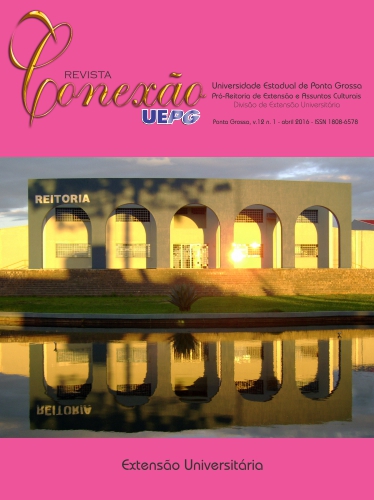LEGAL AND PEDAGOGICAL INTERDISCIPLINARY STUDIES ON THE CHILDREN AND ADOLESCENTES FROM THE TRIPLE BORDER REGION: AN INTERDISCIPLINARY ACTION – DOI: 10.5212/Rev.Conexao.v.12.i1.0011
DOI:
https://doi.org/10.5212/Rev.Conexao.v.12.i1.0011Keywords:
Interdisciplinary Studies, Media, Lowering the age of criminal responsibility.Abstract
This paper presents our extension program project, which is based on the participatory action research approach, and is called “Legal and Pedagogical Interdisciplinary Studies on Children and Adolescents at the Triple Border”. The program was co-developed with professionals and undergraduates from Law School and Education School, connected to the Bureau of Studies and Defense of Youth and Childhood Rights (NEDDIJ, in the Brazilian Portuguese acronym). The project aims at promoting defense actions in aid of children and adolescents living in the bordering cities. Thus, as an attempt to trigger NEDDIJ actions through an interdisciplinary approach, our starting point was the question: to what extent does the media influence the bill on lowering the age of criminal responsibility? Actions were methodologically assigned in weekly meetings and debates about the subject, therefore establishing new communication alternatives between different fields that share common objectives. We expect this program can foster the development of professional independence both for educators and law school newly graduates.Downloads
References
BOURDIEU, Pierre. Sobre a televisão. Rio de Janeiro: Jorge Zahar Ed., 1997.
BRASIL. Constituição da República Federativa do Brasil 1988. Disponível em: <http://www.planalto.gov.br/ccivil_03/constituicao/constituicao.htm> Acesso em: 28 maio 2014.
______. Lei de Diretrizes e Bases da Educação Nacional. Disponível em: <http://www.planalto.gov.br/CCIVIL_03/leis/L9394.htm> Acesso em: 22 agos 2015.
______. Plano Nacional de Educação em Direitos Humanos./ Comitê Nacional de Educação em Direitos Humanos. – Brasília: Secretaria Especial dos Direitos Humanos, Ministério da Educação, Ministério da Justiça, UNESCO, 2007.
________. Senado Federal. Artigo: Redução da maioridade penal. Disponível em: <http://www12.senado.gov.br>. Acesso em 20 de maio de 2014.
CALLEGARI, André Luis; WERMUTH, Maiquel Ângelo Dezordi. “Deu no jornal”: notas sobre a contribuição da mídia para a (ir) racionalidade da produção legislativa no bojo do processo de expansão do direito penal. Revista Liberdades. n.2, p. 56. set-dez, 2009.
CARDIN, Eric Gustavo. As dinâmicas das fronteiras e as vítimas de homicídios em Foz do Iguaçu / PR (2001-2010). Século XXI, Revista de Ciências Sociais, v.3, n°2, p.155-181, jul. dez. 2013.
CERTEAU, Michel De. A Cultura no Plural. 7. ed. Campinas, SP: Papirus, 1993.
CEVASCO, Maria Elisa. Dez lições sobre os estudos culturais. São Paulo: Boitempo Editorial, 2003.
CURY, Munir (Coord.). Estatuto da Criança e do Adolescente comentado. 12. ed. São Paulo: Malheiros, 2013.
DEBORD, Guy. A sociedade do espetáculo. Tradução: Estela dos Santos Abreu. Rio de Janeiro: Contraponto, 1997.
ETGES, Norberto J. Ciência, interdisciplinaridade e educação. Interdisciplinaridade: para além da filosofia do sujeito. 9. ed. P. 60-94. Petrópolis, RJ: Vozes, 2011.
FOUCAULT, Michel. Vigiar e Punir. 29. ed. Petrópolis, RJ: Vozes, 2004.
FREIRE, Paulo. Educação como prática da liberdade. 14. ed. Rio de Janeiro: Paz e Terra, 1983.
______. Pedagogia da Autonomia. 25. ed. São Paulo: Paz e Terra, 1996.
______. Pedagogia do Oprimido. 19 ed. Rio de Janeiro: Paz e Terra, 1991.
______. Política e Educação: ensaios. 5. ed. São Paulo: Cortez, 2001.
KELLNER, Douglas. A Cultura da mídia. Bauru, SP: EDUSC, 2001.
KRAMMER, Sonia et al (Org.). Infância e educação infantil. 11. ed. Campinas, SP: Papirus, 2011.
MARTINS, José de Souza. Fronteira: a degradação do outro nos confins do humano. 2. ed. rev. e atual. São Paulo: Contexto, 2009.
NETTO, Samuel Pfromm. Estatuto da Criança e do Adolescente comentado. 12. ed. São Paulo: Malheiros, 2013.
SANTOS, Boaventura de Souza. Introdução a uma ciência pós-moderna. Rio de Janeiro: Graal, 2010.
SILVA, Antônio Fernando do Amaral e. Estatuto da Criança e do Adolescente comentado. 12. ed. São Paulo: Malheiros, 2013
SILVERSTONE, Roger. Por que estudar a mídia? Trad. Milton Camargo Mota. São Paulo: Loyola, 2002.
SIERRA, V.M.; MESQUITA, W.A. Vulnerabilidades e fatores de risco na vida de crianças e adolescentes.São Paulo em Perspectiva, São Paulo, Fundação Seade, v. 20, n. 1, p. 148-155, jan./mar. 2006. Disponível em: <http://www.seade.gov.br>; http://www.scielo.br>. Acesso em: 13 out. 2013.
SILVERSTONE, Roger. Por que estudar a mídia? Trad. Milton Camargo Mota. São Paulo: Loyola, 2002.
SOTTO, Olympio de Sá SottoMaiot Neto. Redução da maioridade penal é uma falácia. A Nova Democracia. Disponível em: <http://www.anovademocracia.com.br>. Acesso em: 20 maio 2014.
SPEISER, Sabine. Interculturalidad y Educación: Diálogo para la democracia en a America Latina. El para qué de la interculturalidad em la educación. Quito, Ecuador: Ruth Moya, 1999.
THIOLLENT, Michel. Metodologia da pesquisa-ação. 11. ed. São Paulo: Cortez, 2002.
VERCELONE, Paolo. Estatuto da Criança e do Adolescente comentado. 12. ed. São Paulo: Malheiros, 2013
Downloads
Published
Issue
Section
License
a) Authors retain copyright and grant the journal right of first publication with the work simultaneously licensed under a Creative Commons Attribution License that allows others to share the work with an acknowledgement of the work's authorship and initial publication in this journal.
b) By submitting an article to the Revista Conexão UEPG and having it approved, the authors agree to assign, without compensation, the following rights to the Journal: the rights of first publication and the rights to redistribute the article and its metadata to the indexing and reference services that the editors deem appropriate.
c) Readers are free to transfer, print out and use the articles published in the Journal, as long as there is always explicit mention to the author(s) and to the Revista Conexão UEPG and as long as there is no alteration of the original work. Any other use of the texts needs to be approved by the author(s) and by the Journal.






